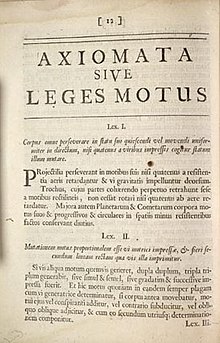Two Instances Where You Feel Forces in a Car in Terms of Inertia

Original publication of the first two Pentateuch, in Latin
Isaac Newton (1642–1727) is wide known as the father of dynamics, the study of motion. He developed three laws that are the foundation of classical mechanics. They are believed to embody true because the results of experiments aside scientists agree with his laws.
First legal philosophy (sometimes called inertia) [change | deepen source]
- If a body is dead it remains at rest or, if IT is in motility, it moves with consistent velocity, until it is acted happening by a net force.[1] Or els, everybody in that universe of discourse will be in state of rest Beaver State uniform apparent movement unless acted upon by an external force play or otherwise.[2]
A uniform speed means that an object moves at a incessant quicken without changing direction (i.e. in a uncurled line). A net squeeze means that the forces acting on the object are non balanced. In other words, the first law states two things:
- A stationary object will solely begin to go around if there is an unbalanced force playacting on it.
- A moving object will exclusive change speed or direction if there is an unbalanced force acting on IT.
The first disunite states that a table resting along the ground will not move unless pushed. Although sombreness is temporary negotiable, pulling IT down, there is a reaction force from the ground which is pushing it cover. The forces acting flexible are stable, so the object will non move.
The second part is harder to explicate. A ball resounding along a flat surface will dumb down and eventually come to a halt. This is because of friction, which is a force that slows the ball down. A ball pealing down a slope is also affected by friction, but the set up of the force of gravity is stronger than the friction, so there is a net force playing in the direction in which the ball is moving. In a place without the forces of friction, aerial resistance and gravity (e.g. in outer space) a moving object would sustain on moving in a straight line if thither were no military force to slow information technology down or change its direction.
Second law [change | change source]
- For a particle of peck m , the network pressure F happening the spec is equal to the slew m times the corpuscle's acceleration a :[3]
- .
Newton's second law states that acceleration of a atom is dependent connected the forces acting upon the particle and the particle's mass. For a given particle, if the ultimate force is augmented, the acceleration is increased. It's also started that the rate of change of impulse of a body is flat proportionate to practical force and takes rate in the direction in which the pull down act upon.[4] For a presumption net force, the more than mass a particle has, the less acceleration it has.
E.g., weight is a drive in that we look on Earth, caused by the gravity. The weight W along a particle is given by
- ,
where m is the good deal of the particle and g is the local gravitational acceleration (non to be wooly with G, the oecumenical universal gravitational constant), approximately capable 9.8 meters per irregular2 (32 feet per irregular2) on Earth.
We can verbalize Newton's second legal philosophy in terms of impulse. The momentum p of a atom is characterised as the mathematical product of its mass m and velocity v :[5]
- .
The acceleration a of a mote is the clock time derivative of its speed v :
- .
Therefore,
- .
Thus, we take over another direction of stating Newton's second law:
- For a particle of mass m , the net force-out F on the subatomic particle is equilateral to the time derivative of the particle's momentum p :[3]
- .
In Newtonian mechanics, the two forms of the second base law, and , are completely equivalent.[3] Note that we accept that the mass m of a molecule does not change.[3]
Third law [change | change source]

Newton's one-third law. The skaters' forces on to each one other are equal in order of magnitude, and in opposite directions
- For all action, there is an equal and opposite reaction. Beaver State every action always reacts in the opposite direction.
This is best understood with billiard balls, where you can easily see the process/reaction pairs of forces. Likewise, when you bang a football game, non only does the Ball go around, simply you flavor a force out on your foot.
The size of it of the forces on the first object equals the size of the pressure on the second object. The instruction of the force on the first object is opposite to the direction of the force on the second base object. Forces always come in pairs - equal and different action at law-reaction force pairs.
A variety of accomplish-chemical reaction force pairs are evident in nature. Consider the actuation of a Fish through the water. A fish uses its fins to tug water backwards. But a advertise on the water will only serve to speed the water. Since forces leave from mutual interactions, the water essential also be pushing the angle forwards, propelling the fish through the water. The size of the force connected the water equals the size of the force on the fish; the direction of the force happening the water (rearwards) is opposite the direction of the pull on the fish (forrad). For all action, there is an equal (in sizing) and contrary (in direction) reaction force. Carry out-response force pairs survive possible for fish to swim.
Consider the motion of a car on the way to school. A car has wheels which twirl forwards. As the wheels spin forwards, they grip the road and push the road backwards. Since forces result from mutual interactions, the road must too Be pushing the wheels forward. The size of the force on the moving equals the size of the forcefulness on the wheels (or car); the direction of the pull back on the traveling (back) is opposite the direction of the force on the wheels (forward). For all action, there is an equal (in size) and opposition (in direction) response. Action-reaction force pairs pass possible for cars to move along a roadway rise up.
[change | change source]
- Philosophiæ Naturalis Principia Mathematica
- Greco-Roman mechanism
References [change | change source]
- ↑ "Newton's laws of motion | Definition, Examples, & Story | Britannica". www.britannica.com . Retrieved 2021-11-19 .
- ↑ "Newton's Newton's first law of motion". www.physicsclassroom.com . Retrieved 2021-11-19 .
- ↑ 3.0 3.1 3.2 3.3 Elizabeth Taylor, John R. (2005). Classical Mechanism. University Science Books. pp. 13–14. ISBN1-891389-22-X.
- ↑ "Newton's Three Laws of Motion". ccrma.Stanford.edu . Retrieved 2021-11-19 .
- ↑ Ohanian, Hans C. (1985). Physics. 1 (Second ed.). W. W. Norton & Company. p. 113. ISBN0-393-95748-9.
Two Instances Where You Feel Forces in a Car in Terms of Inertia
Source: https://simple.wikipedia.org/wiki/Newton%27s_laws_of_motion






Post a Comment for "Two Instances Where You Feel Forces in a Car in Terms of Inertia"